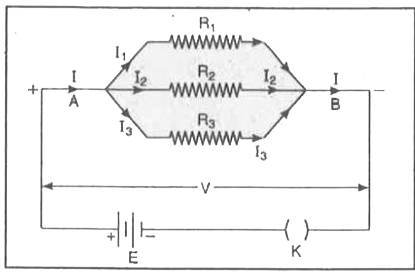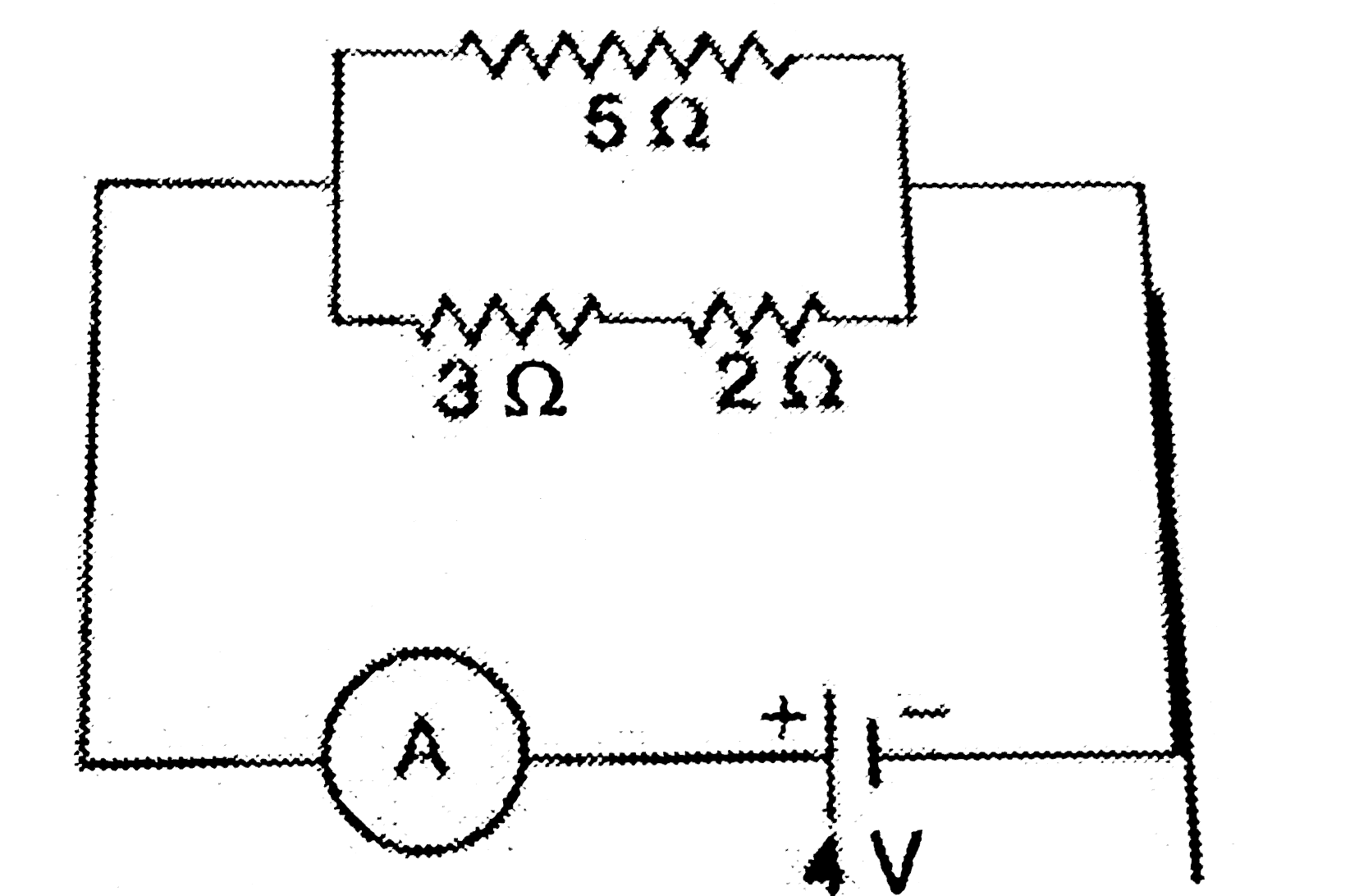Drive expression for the total resistance of a circuit in which a few resistors are connected in parallel.
Resistance in parallel. Resistances are said to be connected in parallel if one end of each resistance is connected at one point and other end is connected to another point so that the potential difference across each resistance is the same. However, current passing through each resistance is a part of the total current.

As shown in the figure.
Let R1,R2andR3 be three resistances connected in parallel and I1,I2andI3 be currents flowing through R1,R2andR3 respectively.
I=total current flowing between A and B.
V=potential difference difference across A and B.
It is clear that
I=I1+I2+I3 . . . (1)
Since the potential difference across R1,R2andR3 is the same i.e., V, according to Ohm.s law.
V=I1R1,V=I2R2andV=I3R3
∴I1=VR1,I2=VR2andI3=VR3 . . . (2)
If Rp is equivalent resistance of the parallel combination, then,
∴I=VRp . . (3)
Putting (2) and (3) in (1) we get
VRp=VR1+VR2+VR3
or 1Rp=1R1+1R2+1R3 . . . (4)
Thus we find that when a number of resistances are connected in parallel, the reciprocals of the resultant resistance is equal to sum of the reciprocal of individual resistances.
It there are n resistances each equal to .R. and if these are in parallel, then resultant is given by :
1Rp=1R+1R+1R+...n times
1Rp=nRorRP=Rn
Thus effective resitances decreases.
Topper's Solved these Questions
- CURRENT ELECTRICITYBOOK - MBD -HARYANA BOARDCHAPTER - CURRENT ELECTRICITYEXERCISE - LONG ANSWER TYPE QUESTIONS
6 Videos
- CURRENT ELECTRICITYBOOK - MBD -HARYANA BOARDCHAPTER - CURRENT ELECTRICITYEXERCISE - OBJECTIVE TYPE QUESTIONS
20 Videos
- CURRENT ELECTRICITYBOOK - MBD -HARYANA BOARDCHAPTER - CURRENT ELECTRICITYEXERCISE - OBJECTIVE TYPE QUESTIONS
20 Videos
- BOARD QUESTION PAPER (SOLVED) - 2019BOOK - MBD -HARYANA BOARDCHAPTER - BOARD QUESTION PAPER (SOLVED) - 2019EXERCISE - LONG ANSWER TYPE QUESTIONS
4 Videos
- DUAL NATURE OF MATTER AND RADIATIONSBOOK - MBD -HARYANA BOARDCHAPTER - DUAL NATURE OF MATTER AND RADIATIONSEXERCISE - OBJECTIVE TYPE QUESTIONS
17 Videos
Similar Questions
Find the total resistance when the various resistors are connected (i) in series and (ii) in parallel.
View SolutionA resistor of 5Ω is connected in series with a parallel combination of a number of resistors each of 5Ω. If the total resistance of the combination is 6Ω , how many resistor are in parallel?
View Solution
Knowledge Check
In a circuit containing two unequal resistors connected in parallel :
AThe current is the same in both the resistorsBA large current flows through the large resistorCThe voltage drop across both the resistances is the sameDThe small resistance has smaller conductanceEquivalent resistance R, of the parallel combination when two resistors Rand R, are connected in parallel is equal to
ARp=R1+R2R1R2BRp=R1R2R1−R2CRp=R1−R2R1+R2DRp=R1+R2R1+R2Circuit A is made of resistors connected in series to a battery, circuit B is made of resistors connected in parallel to a battery. Let P be the power drawn from the batteries. As the number of resistors in each circuit is increased,
APA increases and PB decreases,Bboth PA and PB increaseCPA decreases and PB increases,DPA and PB remain the same
(a) With the help of a circuit diagram, obtain the relation for the equivalent resistance of two resistances connected in parallel.
(b) In the circuit diagram shown below, find:
(i) Total resistance.
(ii) Current shown by the ammeter A

View SolutionWhen two resistors are connected in series with a cell of emf 2 V and negligible internal resistance, a current of 25A flows in the circuit. When the resistors are connected in parallel the main current is 53A. Calculate the resistances.
View SolutionFind an expression for equivalent resistance of three resistors joined in parallel.
View SolutionDerive expression for equivalent resistance of a parallel combination of resistances.
(b) Calculate the ratio of equivalent resistance for a series combination of n number of identical resistors to the parallel combination of the same type of n number of resistors.
View SolutionIn the experiment on finding the equivalent resistance of two resistors, connected in parallel, three students connected the voltmeter in their circuits, in the three ways X, Y and Z shown here.

The voltmeter has been correctly connected in
View Solution
